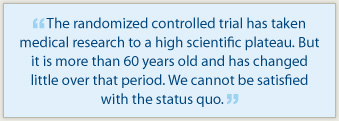 The randomized controlled clinical trial has long been the gold standard for new cancer drugs to demonstrate worthiness of FDA approval; however, many experts contend that that our method of bringing drugs to the market is plagued by undue costs, long delays, and overregulation. According to Donald A. Berry, PhD, Professor, Department of Biostatistics, The University of Texas MD Anderson Cancer Center, we could streamline drug approval by using the Bayesian approach to design more efficient trials. Dr. Berry published an editorial in the Journal of Clinical Oncology about “Adaptive Clinical Trials: The Promise and the Caution,”1,2 and recently spoke about the subject with The ASCO Post.
The randomized controlled clinical trial has long been the gold standard for new cancer drugs to demonstrate worthiness of FDA approval; however, many experts contend that that our method of bringing drugs to the market is plagued by undue costs, long delays, and overregulation. According to Donald A. Berry, PhD, Professor, Department of Biostatistics, The University of Texas MD Anderson Cancer Center, we could streamline drug approval by using the Bayesian approach to design more efficient trials. Dr. Berry published an editorial in the Journal of Clinical Oncology about “Adaptive Clinical Trials: The Promise and the Caution,”1,2 and recently spoke about the subject with The ASCO Post.
Trial Design
What’s the major difference between traditional trial design and Bayesian adaptive design.
That is difficult to answer because traditional trial designs are, in fact, adaptive. The recent push toward adaptive design is actually one of degree. Traditional designs are generally simple, with fixed randomization ratio, fixed treatment arms (usually two), and fixed sample size. The main adaptive aspects of traditional phase III clinical trials are interim analyses, which allow for stopping the trial early and announcing the results.
Traditional cancer trials address a single question, whereas “more adaptive” clinical trials address many questions. These questions may include: Which treatment is best among a set of possibilities, allowing for combination therapies? What doses and schedules? For which patients? Thus, the promise of adaptive clinical trials is that they answer more questions and faster.
Traditional phase III trials tend to be large, and they are getting larger all the time. Think of them as aircraft carriers, while adaptive designs are more like PT boats.
I-SPY 2
Can you share an example of an adaptive trial that you helped design?
Yes, I am coordinating the I-SPY 2 trial (Investigation of Serial Studies to Predict Your Therapeutic Response with Imaging and Molecular Analysis 2) with Laura Esserman, MD, MBA, Director of the Carol Franc Buck Breast Care Center at the University of California, San Francisco (see sidebar).
It’s a phase II drug screening trial in neoadjuvant therapy for breast cancer. At any time there are as many as six arms, including a standard therapy control arm. Using Bayesian predictors of success in a small, focused phase III trial, the arms are replaced as they graduate to phase III or are dropped because of futility. The ultimate goal is to provide information about which drugs benefit which patients, leading to smaller phase III trials that involve patients who respond to the experimental therapy.
Cautionary Note
What should we be cautious about as we move further into this new trial design?
Biases can creep into adaptive trials. For example, if the investigators and others know the adaptations, then such knowledge reveals trial results. This could affect the conduct of the trial and therefore the trial’s credibility.
Caution is indeed appropriate, as the FDA points out in a draft guidance on adaptive designs. Much of the territory is unexplored. It took many years for medical researchers to learn how to properly build and conduct seemingly simple randomized trials. Adaptive trials are usually much more complicated and therefore more challenging.
And some adaptive trial designs are just plain dumb.
Outcome-adaptive randomization seems intuitive. What are the practical obstacles that this model faces in cancer drug development?
Naysayers defending the status quo.
Speed and Efficiency
The Institute of Medicine (IOM) has issued a report to improve speed and efficiency of clinical trial development and activation.3 Does the adaptive clinical trial model help accomplish that goal?
Yes, it does. Indeed, a principal focus of chapter 2 of the IOM report is adaptive clinical trials, and Bayesian adaptive trials, in particular. This excerpt from chapter 2 of the IOM report addresses your question:
[T]he current explosion of biological knowledge demands increased attention to developing trial designs that can take advantage of this knowledge more fully…many clinical trialists are developing approaches to clinical trials that involve multiple stages or otherwise permit increased flexibility by allowing for changes to be made during the trial, based on emerging results. Such design innovations have potential for decreasing the time to study conclusions and improving the likelihood of offering effective treatment to a greater proportion of trial participants.
Endpoints
Where do endpoints factor in when designing adaptive clinical trials?
In one sense the issue is independent of one’s approach to trial design: In an adaptive approach, one adapts to the endpoint. But the timing of the endpoint can affect the usefulness of an adaptive approach. Suppose the endpoint becomes known 2 years after treatment and the trial’s accrual period is shorter than 2 years. Information starts to accrue only after all the patients are treated and therefore no adaptations are possible. In some cancers, overall survival is long (happily so!) and so it is difficult to adapt…unless accrual is very slow.
In many ways cancer has lagged behind other therapeutic areas in being adaptive. But in one way it excels, and that is when the primary endpoint is long in coming. There may be information available about how each patient is doing over time, and this information can be used to model the primary endpoint.
One simple example is disease progression. A patient whose disease has not progressed usually lives longer than one whose disease has progressed. More generally, we may be able to use imaging or other longitudinal biomarkers to assess tumor burden in anticipation of the primary endpoint.
Looking Ahead
Another major issue in our trial system is the waste of intellectual energy and precious resources associated with the extremely high failure rate of clinical trials. Do adaptive trials offer relief from this syndrome?
Of course there are going to be failures; however, with adaptive design, trials involving agents that are not effective in any subset of the disease fail early, saving substantial costs and enabling drug developers to move into more promising directions.
Any last thoughts on the landscape of U.S. clinical cancer trials?
 Atlanta after Sherman’s armies marched through comes to mind. Only one out of three phase III cancer trials is successful. This is the worst of all therapeutic areas, with cardiovascular phase III trials a distant second worst at 46%. One result is the burgeoning cost of cancer therapies. More important is the consequent slow pace of cancer drug development.
Atlanta after Sherman’s armies marched through comes to mind. Only one out of three phase III cancer trials is successful. This is the worst of all therapeutic areas, with cardiovascular phase III trials a distant second worst at 46%. One result is the burgeoning cost of cancer therapies. More important is the consequent slow pace of cancer drug development.
Finally, I want to stress that I am enormously respectful of randomization in clinical trials. The randomized controlled trial has taken medical research to a high scientific plateau. But it is more than 60 years old and has changed little over that period. We cannot be satisfied with the status quo. We must explore ever-higher plateaus. There are dangers along the way but the climb is inevitable. And it will help speed the cures for cancer. ■
Disclosure: Dr. Berry is co-owner of Berry Consultants, LLC. Berry Consultants designs adaptive clinical trials—including some in oncology—for pharmaceutical companies, medical companies, and NIH cooperative groups.
SIDEBAR: A Snapshot of I-SPY 2
References
1. Berry DA: Adaptive clinical trials: the promise and the caution. J Clin Oncol 29:606-609, 2011.
2. Korn EL, Freidlin B: Outcome-adaptive randomization: Is it useful? J Clin Oncol 29:771-776, 2011.
3. Institute of Medicine: A national cancer clinical trials system for the 21st century: Reinvigorating the NCI Cooperative Group Program. http://books.nap.edu/openbook.php?record_id=12879

